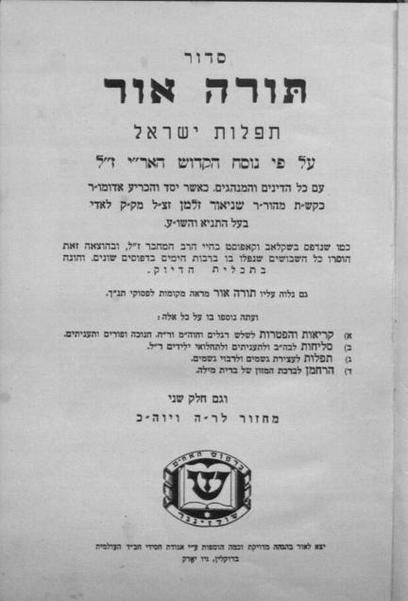Siddur Tifereth David (1951), arranged by Ḥayyim (Hyman) Alter Segal, was the first nusaḥ ha-ARI z”l (“Sephardic-Ḥassidic”) prayerbook with a relatively complete English translation.
In 1912, the Hebrew Publishing company had published the Siddur Tiferet Yehudah by Abraham Ḥayyim (Hyman) Charlap (1862-1916) in both nusaḥ Ashkenaz and “sfard” editions which were reprinted over the next several decades. Indeed, if one compares prayerbooks, Segal’s Tifereth David essentially adds its English translation opposite the Hebrew pages of the Tiferet Yehudah siddur.
A review of the English translation indicates reticence to publish translations of works from the Zohar or Tiqunei Zohar. Pataḥ Eliyahu is left untranslated. “K’Gavneh” from the Zohar on Parashat Terumah, read before ma’ariv after Kabbalat Shabbat is entirely missing. While kavanot are translated, references to the shekhinah are omitted. For an example, see the translation of the kavvanah preceding laying tefilin on page 2.
We are not certain whether the English translation in the Tifereth David was made by Segal, an unattributed translator, or a team of translators. (Segal was an editor for the Hebrew Publishing Company at the time, a detail we know thanks to an acknowledgement given to him in Paltiel Birnbaum’s introduction to his 1949 siddur, Ha-Siddur Ha-Shalem, also published by the Hebrew Publishing Company.)
“Sephardic” here does not refer to the liturgical custom of the Sepharadim, but rather to the liturgical custom of the ḥasidim who followed the school of Lurianic Kabbalah (a/k/a the nusaḥ ha-ARI z”l). Non-ḥasidic Jews referred to this “new” liturgical custom as “Sephardic” as it contained some liturgical customs familiar to some branches of the sepharadi diaspora. The term stuck and has been a familiar source of confusion for newcomers to Jewish prayer ever since.

This work is in the Public Domain due to the lack of a copyright renewal by the copyright holder listed in the copyright notice (a condition required for works published in the United States between January 1st 1924 and January 1st 1964).
This work was scanned by Aharon Varady for the Open Siddur Project from a volume held in the collection of the HUC Klau Library, Cincinnati, Ohio. (Thank you!) This work is cross-posted to the Internet Archive, as a repository for our transcription efforts.
Scanning this work (making digital images of each page) is the first step in a more comprehensive project of transcribing each prayer and associating it with its translation. You are invited to participate in this collaborative transcription effort!
The HEBREW PUBLISHING COMPANY presents, for the first time, a carefully edited and revised English version of the SIDDUR for those who follow the Sephardic[-Ḥassidic] form of worship. There has been a serious need for a Sephardic[-Ḥassidic] Daily Prayer Book with an English translation for many years and it is hoped that Jews who observe the traditional Sephardic[-Ḥassidic] services will find this English version an essential and important book for daily and Sabbath worship.
This volume also includes prayers for additional services as are found in other complete Siddurim in the Ashkenazic service.

“📖 סידור תפארת דוד (נוסח האר״י) | Siddur Tifereth David, a bilingual Hebrew-English prayerbook arranged by Ḥayyim Alter Segal (1951)” is shared through the Open Siddur Project with a Creative Commons Public Domain Dedication 1.0 Universal license.







![Maḥzor haShalem l-Rosh haShanah - Nusaḥ "Sfard" [Ḥassidic] (Paltiel Birnbaum 1958) - title page](https://opensiddur.org/wp-content/uploads/2019/08/title-birnbaum-rh-sefard-mahzor-1958.png)


Unfortunately, we do not know very much about Hyman Alter Segal. He may be the same Hyman Segal who as a young man wrote poetry collected in The Book of Pain-Struggle (1911), contributed Zionist poetry to the anthology New Songs of Zion (ed. Samuel Roth, 1914), and presented his meditation on pain and struggle in a work, The Law of Struggle (Massada Publishing Co., 1918). In the latter, Hyman Segal writes the following about prayer (p.161):
It would certainly be a wonder if this same Hyman Segal later arranged the Siddur Tifereth David. If you know more, please comment below.